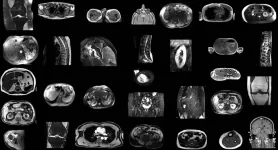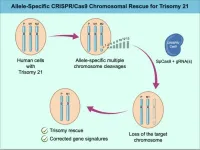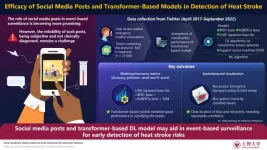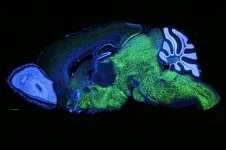(Press-News.org) OAK BROOK, Ill. – Different sociodemographic groups, especially racial and ethnic minorities, are less likely to receive timely breast cancer diagnostic services after an abnormal screening mammogram, according to a study published today in Radiology, a journal of the Radiological Society of North America (RSNA).
Routine yearly screening mammography is an important first step in the early diagnosis of breast cancer. When a screening mammogram comes back as abnormal, additional imaging and image-guided biopsy may be necessary to diagnose breast cancer.
When it is caught early enough, before symptoms are present, breast cancer can be easier to treat and significantly reduces a patient’s chance of dying of cancer. A delay in diagnosis can result in further progression of the disease and a poorer overall prognosis for the patient.
Receiving diagnostic services on the same day of an abnormal screening can aid in a timely cancer diagnosis. However, not all screening facilities offer additional diagnostic or same-day services. This means a potential delay in a cancer diagnosis for many patients.
Researchers from the University of Washington sought to identify if there is a link between sociodemographic factors and access to screening facilities with adequate diagnostic services.
“Many people are aware of the need to reduce disparities in the uptake of screening mammography. However, ensuring availability and receipt of quality diagnostic breast imaging is also necessary to diagnose breast cancer,” said study author Marissa B. Lawson, M.D., M.S., assistant professor of radiology at the University of Washington School of Medicine in Seattle. “Identifying and understanding the disparities in diagnostic breast imaging can facilitate the development of interventions that aim to close gaps in this care pathway and may ultimately improve breast cancer outcomes and patient satisfaction.”
For this retrospective study, Dr. Lawson and colleagues compiled data from six Breast Cancer Surveillance Consortium breast imaging registries.
The data included over 3.5 million screening mammograms that were conducted on 1.1 million women at a total of 136 facilities located throughout the U.S. Of the 1,123,177 women, approximately 10% were Asian, 13% were Black, 6.5% were Hispanic, 68% were white, and 2.2% were “all others.” Of the 9.3% of screenings that resulted in abnormal mammograms, 265,309 examinations were included in the analysis evaluating same-day services.
Approximately 66% of the screening facilities performed same-day diagnostic services. Although onsite availability of most diagnostic services was similar across race and ethnicity groups, the researchers found that racial and ethnic minority groups were less likely to receive standard-of-care diagnostic imaging after abnormal screening compared with white patients.
“Despite having similar availability of diagnostic breast imaging services, there were substantial differences in whether patients received some of these services by race and ethnicity and neighborhood-level socioeconomic status,” Dr. Lawson said.
Racial or ethnic minorities were less likely to have access to some diagnostic technologies within 90 days of their abnormal screening. Compared to white patients, Asian and Black patients were less likely to undergo digital breast tomosynthesis.
Additionally, patients who identified as Asian, Black or Hispanic/Latinx were less likely to receive diagnostic imaging on the same day as their abnormal mammogram. However, Hispanic patients were more likely to receive same day biopsy in comparison to white or Black patients.
Patients living in neighborhoods with a lower average income also experienced disparities in access to diagnostic services.
The researchers note that some interventions may reduce disparities in timely breast cancer diagnosis, such as legislation to require health insurance plans to provide coverage of diagnostic breast imaging without out-of-pocket costs or the establishment of patient navigation services at facilities to help patients arrange timely appointments for diagnostic imaging.
“Future studies should assess other factors that may impact whether patients receive specific diagnostic breast imaging services, such as insurance status or patient preferences,” Dr. Lawson said. “In addition, we should seek to understand how diagnostic breast imaging accessibility, timeliness and quality ultimately impact breast cancer outcomes.”
###
“Disparities in Standard-of-Care, Advanced, and Same-Day Diagnostic Services among Patients with Abnormal Screening Mammography.” Collaborating with Dr. Lawson were Weiwei Zhu, M.S., Diana L. Miglioretti, Ph.D., Tracy Onega, Ph.D., Louise M. Henderson, Ph.D., Garth H. Rauscher, Ph.D., Karla Kerlikowske, M.D., Brian L. Sprague, Ph.D., Erin J. A. Bowles, M.P.H., Ellen S. O’Meara, Ph.D., Anna N. A. Tosteson, Sc.D., Roberta M. diFlorio-Alexander, M.D., M.S., Rebecca A. Hubbard, Ph.D., Janie M. Lee, M.D., M.Sc., and Christoph I. Lee, M.D., M.S.
Radiology is edited by Linda Moy, M.D., New York University, New York, N.Y., and owned and published by the Radiological Society of North America, Inc. (https://pubs.rsna.org/journal/radiology)
RSNA is an association of radiologists, radiation oncologists, medical physicists and related scientists promoting excellence in patient care and health care delivery through education, research and technologic innovation. The Society is based in Oak Brook, Illinois. (RSNA.org)
For patient-friendly information on breast cancer screening, visit RadiologyInfo.org.
END
OAK BROOK, Ill. – Research scientists in Switzerland have developed and tested a robust AI model that automatically segments major anatomic structures in MRI images, independent of sequence, according to a new study published today in Radiology, a journal of the Radiological Society of North America (RSNA). In the study, the model outperformed other publicly available tools.
MRI provides detailed images of the human body and is essential for diagnosing various medical conditions, from neurological disorders to musculoskeletal injuries. For in-depth interpretation of MRI images, the organs, muscles and bones in the images are outlined ...
Despite similar availability of diagnostic technologies to women of different racial and ethnic groups, significant disparities were seen in who actually received same-day diagnostic services and biopsies after abnormal mammogram findings, new research shows. Even when breast-care facilities had the necessary technology and capabilities, minority groups were less likely than white women to receive diagnostic imaging on the same day as an abnormal screening result. Black women in particular were less likely to receive same-day biopsies, compared with white women.
The findings of a retrospective study are to be published ...
New research brings hope for improved outcomes and survival rates for patients facing a pancreatic cancer diagnosis
The discovery of a 'biomarker panel' could have a profound impact on the ability to identify patients at risk of developing PC at an earlier stage
Pancreatic cancer (PC) is the worst prognosis cancer globally, with just 13% of patients who are diagnosed with PC surviving for 5 years or more after initial diagnosis. In Ireland, there are approximately 900 cases of PC per year, and 820 PC-related deaths. Early detection of PC is the primary concern of most PC research, as it has the potential to make a substantial difference to the treatment and survival of patients.
Survival ...
Gene editing techniques may eventually allow trisomy to be treated at the cellular level, according to an in vitro proof-of-concept study. Down syndrome is caused by the presence of a third copy of the 21st chromosome. The condition occurs in approximately 1 in 700 live births and is relatively easy to diagnose at early stages of development. However, there are no treatments. Ryotaro Hashizume and colleagues use the CRISPR-Cas9 gene editing system to cleave the third chromosome in previously generated trisomy 21 cell lines derived from both pluripotent cells and skin fibroblasts. The technique is able to identify which chromosome has been duplicated, ...
Heat stroke poses a significant health risk, especially during extreme temperature conditions. As global temperatures rise due to climate change, the frequency and severity of heatwaves have increased, putting vulnerable populations at greater risk. This shift underscores the need for effective, real-time methods for early detection and response to heat stroke risks, ensuring timely intervention and reduced impact of these rising threats. While previous studies have highlighted the potential of social media posts, such as tweets, to offer real-time insights into various events, its application in detecting heat stroke risks ...
ARLINGTON, Va. (Feb. 18 2025) – A new study led by Conservation International scientists and published today has found that grassland restoration can reduce human-wildlife conflict and social conflicts in communities facing resource scarcity.
Grasslands, vital ecosystems for livelihoods and biodiversity, are under increasing pressure from climate change and human activity. The Chyulu Hills region of Kenya exemplifies these challenges, as it is home to iconic wildlife such as African elephants and black rhinos, which share the land with pastoral Maasai communities. This coexistence often leads to competition over limited water, land and pasture, sparking ...
Some people wake up vividly recalling their dreams from the night, and can tell precise stories experienced during the night, while others struggle to remember even a single detail. Why does this happen? A new study, conducted by researchers at the IMT School for Advanced Studies Lucca, and published on Communications Psychology explores the factors that influence so called "dream recall"— the ability to remember dreams upon awakening—and uncovers which individual traits and sleep patterns shape this phenomenon.
The reason why there is such a difference in recalling dreams remains a mystery. Some studies found that women, young persons, ...
The immune systems of cancer patients are highly disrupted, with those who have a higher number of immune cells in their blood having a better survival rate, finds a new study that uses a pioneering technique developed by researchers at UCL and the Francis Crick Institute.
The tool, described in Nature Genetics, is called Immune Lymphocyte Estimation from Nucleotide Sequencing (ImmuneLENS). It enables researchers to calculate the proportion of T cells and B cells (types of immune cell) from whole genome sequencing (WGS) data for the first time.
Whole genome sequencing (WGS) uses a blood sample to create a complete ...
*** Embargoed for release until Tuesday, Feb. 18, 2025, at 5 a.m. EST ***
A newly identified part of a brain circuit mixes sensory information, memories, and emotions to tell whether things are familiar or new, and important or just “background noise.”
Led by researchers from NYU Langone Health, the work found that a circuit known to carry messages from a brain region that processes sensory information, the entorhinal cortex (EC), to the memory processing center in the hippocampus (HC) has a previously unrecognized pathway that carries messages directly back to the EC.
Publishing online Feb. 18 in Nature Neuroscience, the study results show that this direct feedback ...
The origins of human language remain mysterious. Are we the only animals truly capable of complex speech? Are Homo sapiens the only hominids who could give detailed directions to a far-off freshwater source or describe the nuanced purples and reds of a dramatic sunset?
Close relatives of ours such as the Neanderthals likely had anatomical features in the throat and ears that could have enabled the speaking and hearing of spoken language, and they share with us a variant of a gene linked to the ability to speak. And yet it is only in modern humans that we find expanded brain regions that are critical for language production and comprehension.
Now researchers from The Rockefeller University ...



